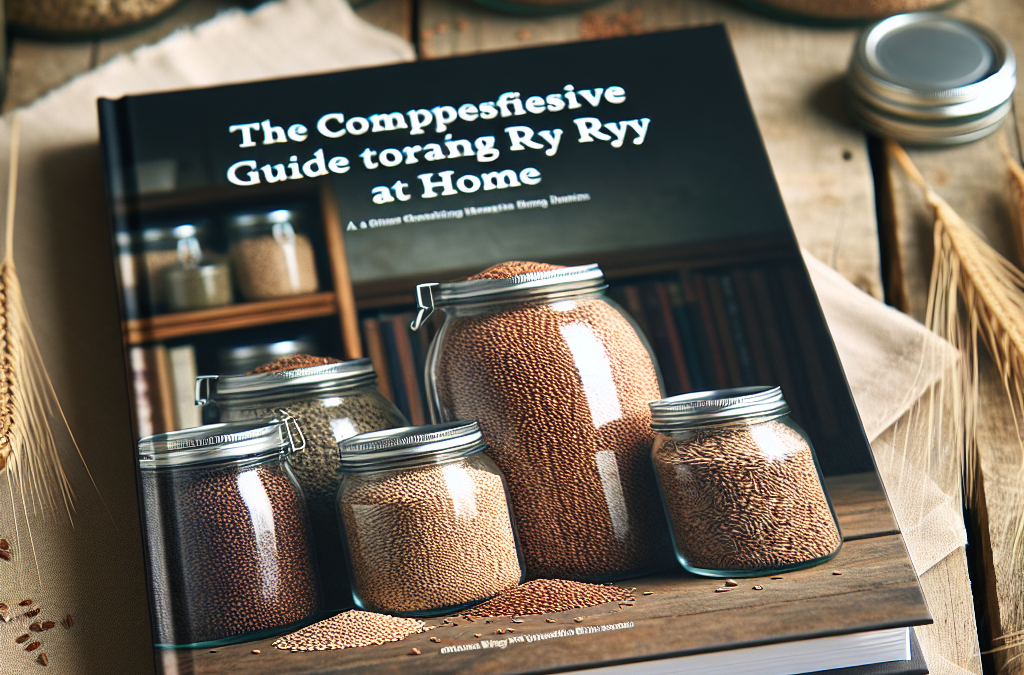Understanding the Basics of Rye and Barley
Why Store Rye and Barley?
Storing rye and barley can be a game changer for those of us who like to dip our toes into baking, brewing, or simply enjoying whole grains. These grains have a wide range of uses, and stocking up can save you time and money! Personally, I find that having a stash of these grains on hand means I’m always ready to whip up something delicious.
Moreover, when properly stored, they can last for a long time. This means you can buy in bulk when prices are low, reducing your grocery bills in the long run. There’s nothing quite like knowing you’re prepared for your culinary adventures!
Lastly, with the right storage techniques, you can maintain the flavor and nutritional quality of your grains for months, sometimes years. Trust me, it feels great to know that you’re not only saving money but also putting healthy food options on your table.
Identifying Quality Grains
Choosing high-quality rye and barley is fundamental to successful storage. I remember my first time at the local grain market; I got overwhelmed! However, I learned to look for grains that are whole, with no visible damage or spoilage. Freshness is key.
Additionally, check for the aroma. Fresh grains should have a nutty scent—if they smell musty, that’s a red flag. You want the best quality for your home storage, and it pays off in the long run.
Lastly, read the packaging carefully. Make sure it’s a reputable brand and consider checking the date. Fresh grains mean longer storage potential and better flavors in your meals.
Different Types of Rye and Barley
There are several types of rye and barley, each providing its unique flavor and texture. For example, I love using whole grain rye for my breads; it adds a depth that just can’t be beat.
For barley, you’ll find hulled barley, which is less processed, and pearl barley, which cooks faster. Both are wonderful, but choosing which one to store depends on what you plan to cook or bake.
By exploring different variations, you can diversify your meals and also have fun experimenting with new recipes. Plus, it’s always good to learn more about what you consume!
Choosing the Right Storage Containers
Material Matters
This is where the fun begins—picking out the perfect containers! From experience, I can tell you that glass jars with airtight lids are fabulous for storage. They seal in freshness like no other.
You can also go for food-grade plastic containers, which can be quite sturdy. However, ensure they are BPA-free to keep your grains safe from unwanted chemicals. A simple check can save you a lot of headaches later!
If you’re feeling adventurous, and you have a little extra space, vacuum-sealed bags are a fantastic option too! They keep out moisture and air, which is a plus for grain longevity.
Size Matters
When selecting containers, size is key. Depending on how much rye and barley you plan to store, you might want different sizes. I often buy my grains in bulk, so I use larger bins for long-term storage.
On the flip side, if you’re just starting out, a couple of medium jars may do the trick. You can always transfer your grains once you have a better understanding of your usage.
Remember, it’s all about convenience and efficiency in your kitchen. When everything is organized and only a quick reach away, it can really change your cooking game!
Labeling Your Containers
Trust me, labeling is a lifesaver! We all have busy lives, and the last thing you want is to confuse your rye with your barley. I label all my grains with the type and date of storage, and it’s made such a difference.
You can get fancy with printable labels, or just grab a good old permanent marker. Just make sure it’s easy to read! And don’t forget to indicate whether they’re raw or cooked.
Keeping everything properly labeled makes your life easier, especially during meal prep. No one wants to dig through bins trying to remember what they stored last month!
Maintaining Ideal Storage Conditions
Temperature Control
When it comes to storing grains, temperature plays a significant role. I’ve learned that keeping rye and barley in a cool, dry place is the way to go. Think pantry or a climate-controlled basement.
If your home tends to get hot, consider using the fridge for short-term storage. I’ve done it myself during summer months, and it works like a charm! Just make sure the containers are airtight to avoid moisture.
The key is to keep it consistent; fluctuations in temperature can wreck havoc on your grains. Establish a stable environment to enjoy healthy grains for longer.
Get Whole Wheat Flour, Grains and Milling Supplies – CLICK HERE
Humidity and Light Protection
Humidity is another factor that can spoil your grains. I was blown away when I first learned that exposure to moisture could lead to mold and a handful of other nasty issues. So, keep those grains dry!
Protecting your storage area from light is just as important. Direct sunlight can break down the quality over time. I’ve got my grains tucked away in a dark cupboard, and it seems to be serving them well!
Remember to regularly check your grains for any signs of spoilage. Being proactive can help you catch issues before they ruin your precious stash!
Regular Inventory Checks
Do yourself a favor and periodically check on your grain stash. I usually set a reminder once every few months to do a little inventory. It helps ensure you’re using them up before they go bad.
While you’re checking, keep an eye out for any pests! Thankfully, I haven’t had an issue, but I always advise everyone to be vigilant when it comes to grain storage.
Keeping track of your inventory means proactively managing your supply and ensuring you’ll always have what you need for your next culinary adventure!
Using Your Stored Rye and Barley
Recipe Ideas
Now that you’ve got your grains stored properly, what’s next? It’s time to get cooking! A personal favorite of mine is rye bread. It’s hearty, healthy, and oh-so-satisfying.
Barley can be used in soups, stews, or even salads. I love making a barley salad with lots of fresh vegetables and a zesty dressing. It’s a healthy addition to any meal, and it’s easy to throw together!
Mix things up, and don’t be afraid to experiment! You may discover some unexpected, delightful combinations that become household favorites.
Preservation Techniques
If you find yourself with an abundance of grains, consider preservation methods like fermentation. I’ve tried fermenting barley for a delicious, unique flavor in my bread, and it’s a must-try!
You can also explore sprouting your grains. It sounds fancy, but it’s doable and truly enhances the nutritional value. Plus, it adds a different texture to your dishes!
Cooking grains in bulk can be a time-saver too. Prepare a large batch and freeze them in smaller portions. Create a grain-friendly meal plan to maximize what you have stored!
Waste Reduction Strategies
We all hate wasting food! Proper storage helps minimize waste, but I’ve also become savvy in using leftovers creatively. Think beyond the initial dish!
Rye breadcrumbs can be a fantastic addition to various recipes, and barley can be tossed into a stir-fry or even smoothies! The possibilities are endless.
Always be on the lookout for ways to incorporate leftover grains into your meals. It’s a fun challenge and a great way to maintain a sustainable kitchen environment!
FAQ
1. How long can I store rye and barley?
When stored properly, whole grains like rye and barley can last for a year or two! Just keep them cool, dry, and away from sunlight!
2. Can I store grains in the fridge?
Absolutely! Storing them in the fridge is a great option, especially in hot and humid conditions, as long as they are in airtight containers.
3. What’s the best way to keep pests away?
Keeping your grains in airtight containers will help prevent pests. Also, keep an eye out for any signs of trouble during your inventory checks!
4. Are there special containers I should use?
Glass jars and food-grade plastic containers work great! The vital point is making sure they seal well to keep out moisture and pests.
5. What are some beginner recipes I can try with rye and barley?
A simple rye bread recipe or a barley salad loaded with fresh veggies can be an enjoyable start! It’s super easy, and you’ll feel great about using your stored grains!
Get Whole Wheat Flour, Grains and Milling Supplies – CLICK HERE
Related Content
Auto Amazon Links: No products found.





